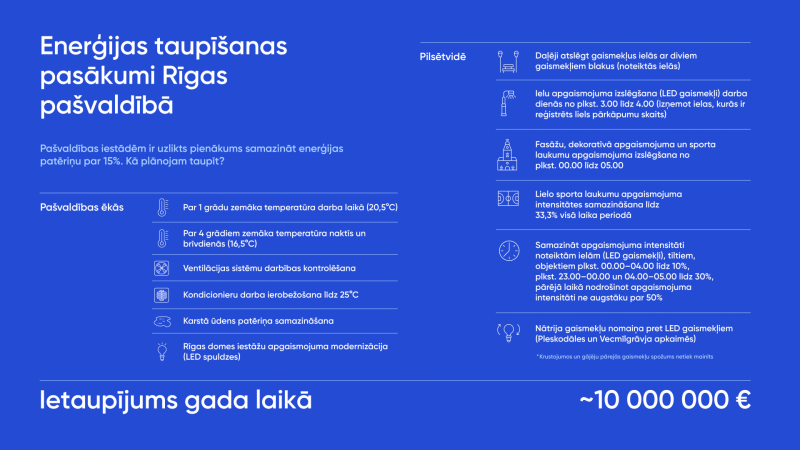In a bid to lower electricity consumption at a time of soaring energy costs, Riga Municipality will introduce various electricity-saving measures, such as reducing lighting intensity, switching off street lighting and facade decorative lighting during certain hours of the night, and changing the type of street lighting in some neighbourhoods of Riga.
Municipal agency “Rīgas enerģētikas aģentūra” and “Rīgas gaisma” developed proposals for electricity saving measures, which have been approved by Riga City Council Chairman Mārtiņš Staķis. "For many of us, saving energy has become part of our daily routines. This area is now also a priority at the national level, so I would like to invite our residents and visitors to Riga to be understanding of the changes that the municipality is introducing in the urban environment. Riga City Council has found an opportunity to save several million euros, while at the same time taking care of everyone's well-being, as the changes introduced will not have a significant impact on the daily lives of residents. That is why these austerity measures have been drafted after a thorough assessment and analysis of the data," says M. Staķis.
The greatest energy savings will be achieved by turning lights off. Switching off the lights can be handled automatically from the “Rīgas gaisma” dispatching service. By analysing data on the movement of people and the number of offences during the day, a period of time has been specified during which it is possible to switch off the street lights, i.e., from 3.00 to 4.00, except for streets where a high number of offences has been recorded. This will reduce electricity consumption by 6.7% (1872 MWh per year).
The lighting of building facades, decorative lighting and sports grounds is scheduled to be switched off during the 00.00–05.00 period. In most institutions, decorative lighting is controlled by a dusk sensor, so astronomical clocks are needed in order to switch it off at night, but these are economically feasible and will pay for themselves in less than a year. This measure will reduce electricity consumption by 1.6% (455.323 MWh per year).
It is planned to switch off the decorative lighting, for example, at such objects as 11 November Embankment, Suspension Bridge stays, South Bridge decorative lighting, Stone Bridge decorative ball lighting, decorative lighting of St. Peter's and Cathedral Churches, VEF Palace of Culture, decorative lighting of facades of several Riga primary, secondary and gymnasium school buildings, etc. It is also planned to reduce the lighting intensity of the Riga 84 Secondary School sports field and the Centre Sports Quarter to 33.3% over the whole period.
The “Rīgas gaisma” agency has been instructed to reduce the intensity of lighting on certain streets, bridges and objects: 00.00 - 04.00 down to 10%; 23.00 - 00.00 and 04.00 - 05.00 down to 30%, with a maximum lighting intensity of 50% at all other times. The Riga Municipality stresses that the reduction of lighting level does not pose any significant safety risks during the dark hours of the day, when the population is less mobile. These activities result in a 1.9% reduction in electricity consumption (536.196 MWh per year).
Several streets in Riga have historically had two luminaires located next to each other, providing a higher intensity of lighting, so one luminaire is scheduled to be switched off. This measure will reduce energy consumption by 3.6% (1023.99 MWh/year).
"When assessing the possibilities to reduce electricity consumption in street lighting, we looked for solutions that would have the least impact on the city's residents," says acting director of “Rīgas gaisma”, Agrita Klinklāva-Dimante.
Riga Municipality will also organise the replacement of sodium luminaires with LED luminaires in the Pleskodāle and Vecmīlgrāvis neighbourhoods. The planned reduction in energy consumption is 2.7% (768.427 MWh/year).
In previous years, Riga Municipality encouraged residents to install façade lighting in the city, for which a real estate tax rebate was granted. In order to ensure that residents can turn off the lights without losing this rebate, Riga City Council intends to amend the Regulations on the Procedure for Granting Real Estate Tax Relief by removing the condition that during the dark hours of the day until 00.00, and after 05.00, permanent operation of decorative lighting on the facade of a building is required. These changes will be implemented for a fixed period of time.
"The proposals put forward and approved are the best possible solution to the current situation of historically unprecedented electricity costs. The proposals were drawn up based on feasibility study. The total cost of providing street lighting, without the implementation of austerity measures, would already be twice as high in 2022 compared to 2021," explains Jānis Ikaunieks, Director of the Riga Energy Agency.
We previously reported that, at the beginning of August, Riga City Council Chairman Mārtiņš Staķis instructed all municipal buildings to reduce their thermal energy consumption by at least 15% during the 2022/2023 heating season. A set of activities that already contribute to the target include temperatures 1 degree lower during working hours and 4 degrees lower temperatures at night and on weekends, controlling ventilation systems, limiting the use of air conditioners and reducing hot water consumption. Many municipal buildings already have automatic indoor temperature control.
Some buildings with individually controlled thermostats are set at 20.5 oC, while corridors are set to around 18 oC. Local authorities also use a minimum set temperature in educational establishments. (the national minimum temperature in schools is 18oC, and in nursery groups with children under three the minimum temperature is 20 oC.)
Author: Solvita Brence-Kauste, External Communication Division Project Coordinator at the of Riga City Council Communication Department, e-mail: solvita.brence@riga.lv




